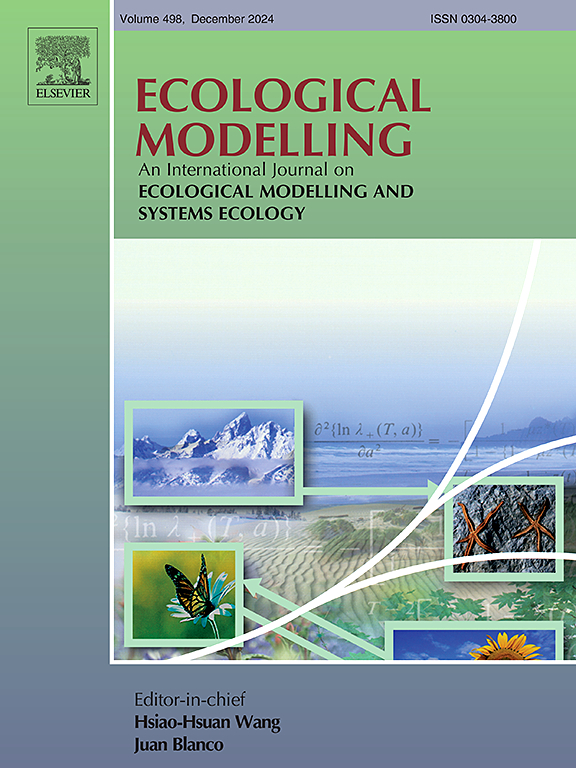淡水鱼生境选择的单变量和多变量空间需求模型的比较分析——以伊朗Jajroud河的Oxynoemacheilus bergianus为例
IF 3.2
3区 环境科学与生态学
Q2 ECOLOGY
引用次数: 0
摘要
了解河流生态系统中鱼类的栖息地需求是保护和制定管理决策的关键因素。其中一个主要问题是,该物种需要的每种变量(速度、深度和基质结构)的最佳范围是什么?这些范围是如何影响其发展和生存的?鉴于在中尺度尺度上对白桦褐叶蝉生境选择的生物学和生态学信息的缺乏,本调查旨在为上述问题提供答案。为此,研究了流速、水深和基质组成三个主要变量对伊朗北部水生生态系统中物种栖息地选择的影响。结果表明,对于幼鱼组,深度可达20 cm,速度为15-20 cm。S-1和细、中砾石为主的基质是最适宜的范围。对于成虫组,深度20-30厘米,速度15-30厘米。我们使用单变量和多变量方法来解决这些问题,这导致不同方法的变量重要性、模型精度和不确定性不同。具体来说,在单变量分析中,流速被确定为最显著的变量。在多变量方法中,深度变量更为重要。最小值法(MI)和算术平均值法(AM)的误差和不确定度分别在组合方法中最低和最高。广义线性模型(GLM)和随机森林模型(RF)分别对幼龄和成虫种群的物种分布模型(SDMs)最准确。利用这些重要的结果将使管理人员能够做出明智的决定,以保护柏氏蛙,最终制定有效的策略,保护其栖息地,确保该物种的长期生存。本文章由计算机程序翻译,如有差异,请以英文原文为准。
A comparative analysis of univariate and multivariate spatial requirements modeling for habitat selection in freshwater fish: A case study of Oxynoemacheilus bergianus in the Jajroud River, Iran and implications for conservation and management
Understanding the habitat requirements for fish in fluvial ecosystems is a key factor in conservation and making decisions for management. One of the main questions is what are the optimal ranges for each variable-velocity, depth, and substrate structure-that the species requires, and how do these ranges influence its development and survival? Given the scarcity of biological and ecological information on Oxynoemacheilus bergianus habitat selection at the mesoscale, this survey was designed to provide an answer to the aforementioned question. For this purpose, the effects of three main variables, including flow velocity, water depth, and substrate composition on the habitat selection of the species in a lotic ecosystem in northern Iran were evaluated. The results indicate that for the juvenile group, depths up to 20 cm, velocities of 15–20 cm.s-1, and a dominant substrate of fine and medium gravel are the most suitable ranges. For the adult group, depths of 20–30 cm, velocities of 15–30 cm.s-1, and small cobbles are preferred We addressed these questions using both univariate and multivariate approaches, which resulted in different variable importance, model accuracy, and uncertainty across methods. Specifically, flow velocity was identified as the most significant variable in the univariate analysis. The depth variable was more important in the multivariate approach. The minimum method (MI) and the arithmetic mean (AM) method had the lowest and highest error and uncertainty among the combined methods, respectively. The Generalized Linear Models (GLM) and Random Forest Models (RF) approaches showed the most accurate models in the Species Distribution Models (SDMs) for juvenile and adult groups, respectively. Utilizing these vital results will empower managers to make informed decisions aimed at conserving O. bergianus, ultimately leading to effective strategies that protect its habitat and ensure the species' long-term survival.
求助全文
通过发布文献求助,成功后即可免费获取论文全文。
去求助
来源期刊

Ecological Modelling
环境科学-生态学
CiteScore
5.60
自引率
6.50%
发文量
259
审稿时长
69 days
期刊介绍:
The journal is concerned with the use of mathematical models and systems analysis for the description of ecological processes and for the sustainable management of resources. Human activity and well-being are dependent on and integrated with the functioning of ecosystems and the services they provide. We aim to understand these basic ecosystem functions using mathematical and conceptual modelling, systems analysis, thermodynamics, computer simulations, and ecological theory. This leads to a preference for process-based models embedded in theory with explicit causative agents as opposed to strictly statistical or correlative descriptions. These modelling methods can be applied to a wide spectrum of issues ranging from basic ecology to human ecology to socio-ecological systems. The journal welcomes research articles, short communications, review articles, letters to the editor, book reviews, and other communications. The journal also supports the activities of the [International Society of Ecological Modelling (ISEM)](http://www.isemna.org/).
 求助内容:
求助内容: 应助结果提醒方式:
应助结果提醒方式:


